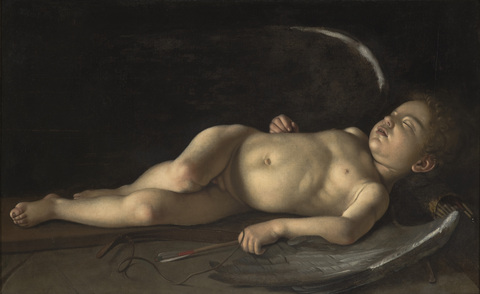Marks, Inscriptions, and Distinguishing Features
None
Entry
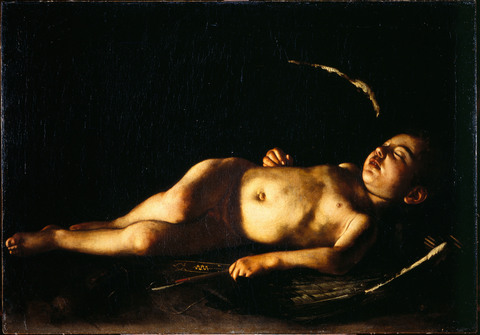
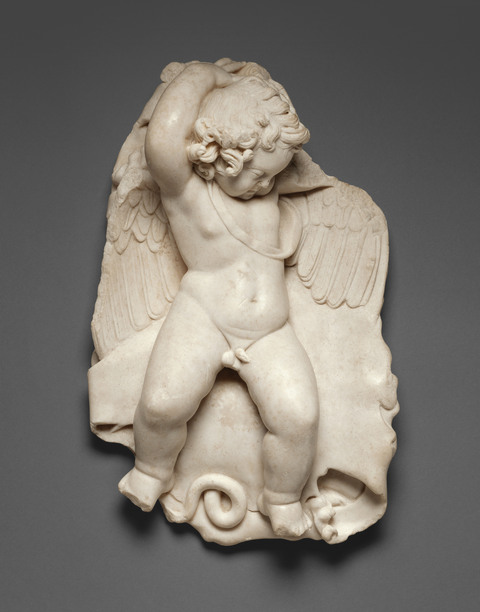
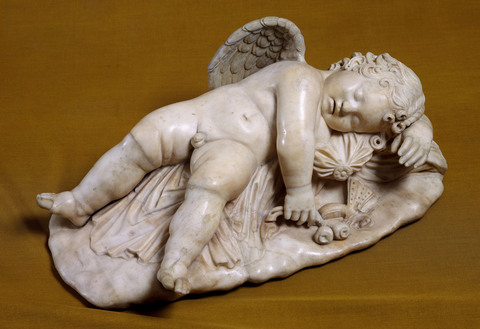
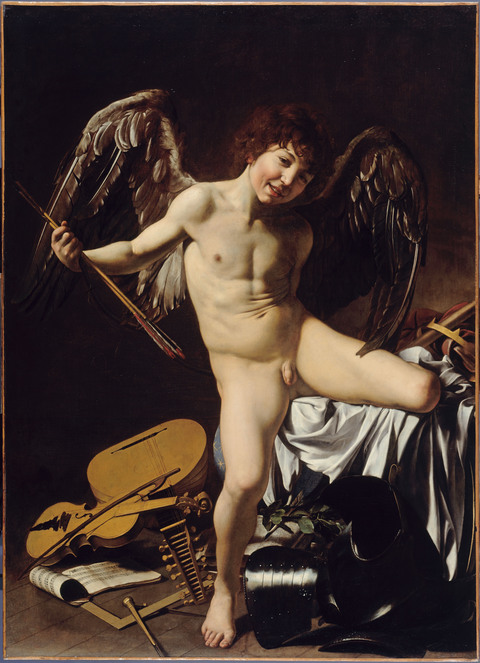
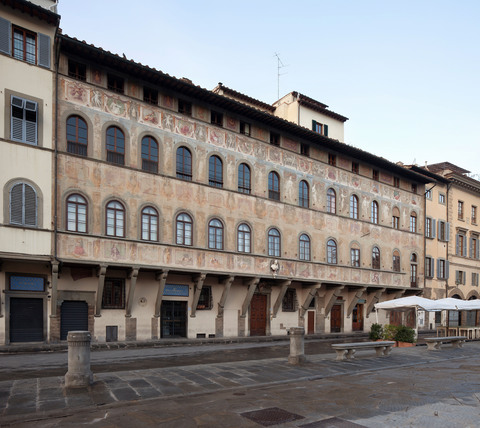
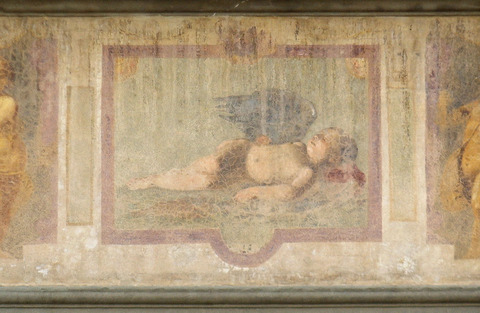
Author
Provenance
Possibly a private collection or convent in Ireland.26
Ivan N. Podgoursky (1901-1962), New York and Boston, by 1948;27
G.H.A. Clowes, Indianapolis, in 1951–1952;28
Exhibitions
John Herron Art Museum, Indianapolis, 1959, Paintings from the Collection of George Henry Alexander Clowes: A Memorial Exhibition, no. 13 (reproduced);
Indiana University Art Museum, Bloomington, 1962, Italian and Spanish Paintings from the Clowes Collection, no. 22;
Detroit Institute of Arts, Detroit, 1965, Art in Italy, 1600–1700, no. 4;
Wildenstein and Co., New York, 1968–1969, Gods and Heroes—Baroque Images of Antiquity, no. 3;
Milan, Palazzo Reale, 2000–2001, Il Cinquecento Lombardo. Da Leonardo a Caravaggio, no. IX.4;
Museum Kunst Palast, Düsseldorf, 2006, Caravaggio: Auf den Spuren eines Genies, no. 2;
Salander-O’Reilly, New York, 2007–2008, Caravaggio, no. 6;
Guangdong Museum, Guangzhou, China; Hunan Museum, Changsha, China; Chengdu Museum; 2020–2021, Rembrandt to Monet: 500 Years of European Painting.
References
Walter Friedlaender, Caravaggio Studies (Princeton: Princeton University Press, 1955), 212, no. 38B, pl. 54;
Paintings from the Collection of George Henry Alexander Clowes, exh. cat. (Indianapolis: John Herron Art Museum, 1959), no. 13;
André Berne-Joffroy, Le dossier Caravage (Paris: Editions de Minuit, 1959), 340–342;
René Jullian, Caravage (Lyon: IAC, 1961), 186, 194 (note 21), 230;
Italian and Spanish Paintings from the Clowes Collection, exh. cat. (Bloomington: Indiana University Art Museum, 1962), no. 22;
Art in Italy, 1600–1700, exh. cat. (Detroit: Detroit Institute of Arts, 1965), 26–27, no. 4;
Howard Hibbard and Milton Lewine, “Seicento at Detroit,” The Burlington Magazine 107, no. 748 (July 1965): 371;
Michael Kitson, The Complete Paintings of Caravaggio (New York: Harry N. Abrams, 1967), 106–107;
Alfred Moir, The Italian Followers of Caravaggio (Cambridge, MA: Harvard University Press, 1967), 1:212 (note 3).
Gods and Heroes—Baroque Images of Antiquity, exh. cat. (New York: Wildenstein and Co, 1968–69) no. 3, fig. 15.
Evelina Borea, Caravaggio e Caravaggeschi nelle Gallerie di Firenze (Florence: Sansoni, 1970), 6;
Luigi Salerno, “Caravaggio e i Caravaggeschi,” Storia dell’arte 7/8 (1970): 236, 241;
A. Ian Fraser, A Catalogue of the Clowes Collection (Indianapolis: Indianapolis Museum of Art, 1973), xxvii, 42–43;
Maurizio Marini, Io Michelangelo da Caravaggio (Rome: Studio B di Bestetti e Bozzi, 1973–1974), 248, 441;
Giorgio Fulco, “Ammirate l’altissimo pittore: Caravaggio nelle rime inedite di Marzio Milesi,” Ricerche di storia dell’arte 10 (1976): 76, no. 10;
Alfred Moir, Caravaggio and His Copyists (New York: New York University Press for the College Art Association of America, 1976), 8, 102, no.42d;
Anthony F. Janson and A. Ian Fraser, 100 Masterpieces of Painting (Indianapolis: Indianapolis Museum of Art, 1980), 63–65;
Mia Cinotti, Michelangelo Merisi detto il Caravaggio: Tutte le opera (Bergamo: Poligrafiche Bolis, 1983), 433;
Maurizio Marini, Caravaggio: Michelangelo Merisi da Caravaggio “pictor praestantissimus”: la tragica esistenza, la raffinate cultura… (Rome: Newton, 1987), 284, 530, 532;
Avigdor W.G. Posèq, “A Note on Caravaggio’s Sleeping Amor,” Source: Notes in the History of Art 6, no. 4 (Summer 1987): 27, 31;
Avigdor W.G. Posèq,” Caravaggio and the Antique,” Artibus et Historiae 11, no. 21 (1990): 161;
Flavio Caroli, Il Cinquecento Lombardo – da Leonardo a Caravaggio, exh.cat. (Milan: Skira, 2000), no. IX.4 (by Maurizio Marini);
Karen Michels, “‘Pineapple and Mayonnaise—Why Not?': European Art Historians Meet the New World,” in The Art Historian: National Traditions and Institutional Practices, ed. Michel F. Zimmermann (New Haven and London: Yale University Press, 2002), 64, fig. 7 (photograph of Walter Friedlaender lecturing at NYU with Sleeping Cupid on an easel in his classroom, date unknown, possibly 1951);
Caravaggio: The Final Years, exh. cat. (London: The National Gallery, 2005), 116–118;
David M. Stone, “‘Fra Michelangelo’ and the Art of Knighthood,” in Keith Sciberras and David M. Stone, Caravaggio: Art, Knighthood and Malta (Valletta: University of Malta, 2006), 84–85;
Jürgen Harten and Jean-Hubert Martin, eds., Caravaggio: Originale und Kopien im Spiegel der Forschung, exh. cat. (Ostfildern: Hatje Cantz, 2006), no. 2, 112, 206–207;
Edward Clark, ed., Caravaggio, exh. cat. (New York: Salander-O’Reilly in association with Whitfield Fine Art London, 2007), 70, no. 6 (reproduced);
Genevieve Warwick, “Memory’s Cut: Caravaggio’s Sleeping Cupid of 1608,” Art History 40, no. 4 (September 2017): 901 (note 9) DOI: 10.1111/1467-8365.12345.
Kjell M. Wangensteen et al., Rembrandt to Monet: 500 Years of European Painting (Nanjing: Jiangsu Phoenix Literature and Art Publishing, 2020), 76–77 (reproduced);
Kjell M. Wangensteen et al., Floating Lights and Shadows: 500 Years of European Painting (Nanjing: Jiangsu Phoenix Literature and Art Publishing, 2020), 74–75 (reproduced).
Notes
-
This work’s documented history goes back only to the mid-twentieth century when it was imported into the United States from an unknown location. See the Provenance section of this entry. ↩︎
-
See Jean Sorabella,"Eros and the Lizard: Children, Animals, and Roman Funerary Sculpture,” Hesperia Supplements, vol. 41 (2007): 353-370. ↩︎
-
Translation from Greek Anthology, Loeb ed., vol. V, 285; cited in Paul F. Norton, “The Lost Sleeping Cupid of Michelangelo,” The Art Bulletin 39, no. 4 (Dec., 1957): 251–257, 256 n. 25, and Anthony Colantuono, “Caravaggio’s Literary Culture,” “Caravaggio’s Literary Culture,” in Genevieve Warwick, Caravaggio: Realism, Rebellion, Reception (Newark: University of Delaware Press, 2006), 57–68, 61. ↩︎
-
Paul F. Norton, “The Lost Sleeping Cupid of Michelangelo,” The Art Bulletin 39, no. 4 (Dec., 1957): 251-257. ↩︎
-
On the Sleeping Cupid in the Uffizi, see Phyllis Pray Bober and Ruth Rubinstein, Renaissance Artists & Antique Sculpture: A Handbook of Sources (London: Harvey Miller Publishers, 2010) 2nd edition, cat. no. 51; see also Catherine Puglisi, Caravaggio (London: Phaidon Press, 1998), 296. For the suggestion that Michelangelo’s model was the sculpture now in the Uffizi, see Paul F. Norton, “The Lost Sleeping Cupid of Michelangelo,” The Art Bulletin 39, no. 4 (Dec., 1957): 251–257, 256. ↩︎
-
Paul F. Norton, “The Lost Sleeping Cupid of Michelangelo,” The Art Bulletin 39, no. 4 (Dec., 1957): 251–257, 251. ↩︎
-
On the first, lost, and little-known Sleeping Cupid made in Rome, see Genevieve Warwick, “Memory’s Cut: Caravaggio’s Sleeping Cupid of 1608,” Art History 40 (Sept., 2017): 884–903, esp. 886–887. ↩︎
-
See Elizabeth Cropper, “The Petrifying Art: Marino's Poetry and Caravaggio,” Metropolitan Museum Journal 26 (1991): 193–212. ↩︎
-
Catherine Puglisi, “Caravaggio’s Life and Lives Over Four Centuries,” in Genevieve Warwick, Caravaggio: Realism, Rebellion, Reception (Newark: University of Delaware Press, 2006), 23–35, esp. 30. ↩︎
-
The Uffizi’s Sleeping Cupid is in poor condition according to Sybille Ebert Schifferer [Caravaggio. The Artist and His Work (Los Angeles: The J. Paul Getty Museum, 2012), 219], who notes “extreme abrasion of the surface, particularly on the areas of the skin, where much of the dark ground is showing through.” ↩︎
-
Ludovica Sebregondi Fiorentini, “Francesco dell’Antella, Caravaggio, Paladini e altri,” Paragone, nos. 383–85 (1982): 107–122, esp. 113. ↩︎
-
“[…] un quadro di mano di Michelangelo da Caravaggio, dentrovi un Cupido che dorme […].” Archivio Buonarroti, filza 104, fol. 145r, letter from Fra Francesco Buonarroti to Michelangelo Buonarroti the Younger, Malta, 20 July 1609; first published in Ludovica Sebregondi Fiorentini, “Francesco dell’Antella, Caravaggio, Paladini e altri,” Paragone, nos. 383–385 (1982): 107–122, esp. 122. ↩︎
-
Archivio Buonarroti, filza 46, fol. 756r, Letter from Fra Francesco dell’Antella to Michelangelo Buonarroti the Younger, Malta, 24 July 1609; first published in David M. Stone, “The Context of Caravaggio’s Beheading of St John in Malta,” The Burlington Magazine 139, no. 1128 (1997): 161–170, esp. 168. ↩︎
-
Maurizio Marini, Caravaggio: Michelangelo Merisi da Caravaggio ‘pictor praestantissimus’, (Rome: Newton & Compton editori, 1987), entry no. 85. ↩︎
-
Catherine Puglisi, Caravaggio (London: Phaidon Press, 1998), 149, following Avigdor W.G. Posèq, “Caravaggio and the Antique,” Artibus et Historiae 11, no. 21 (1990): 147–167. Caravaggio was indeed called “Michelangelo” in Malta, signing his Beheading of St. John the Baptist (1608) for the Knights’ Oratory at the Co-Cathedral of St. John in Valletta with the formula “f. Michelang.” On this signature, see David Stone, “Signature Killer: Caravaggio and the Politics of Blood,” The Art Bulletin 94, no. 4 (December 2012): 272–293. ↩︎
-
Mina Gregori, ed., Michelangelo Merisi da Caravaggio: Come nascono i capolavori, exh. cat. (Florence: Palazzo Pitti and Rome: Palazzo Ruspoli/Milan: Electa, 1991), entry no. 19. For a deeper consideration of poppies and the iconography of sleeping Cupid figures in art, see Genevieve Warwick, “Memory’s Cut: Caravaggio’s Sleeping Cupid of 1608,” Art History 40 (Sept., 2017): 892–896. ↩︎
-
William E. Wallace, Michelangelo. The Artist, the Man, and His Times (Cambridge: Cambridge University Press, 2010), 244–245. ↩︎
-
Angelantonio Spagnoletti, Stato, aristocrazie e ordine di Malta nell’Italia moderna (Bari: Università degli Studi, Rome: Ecole français de Rome, 1988), 33, 77–78. Spagnoletti points out that, among Florentines, joining the Order of Santo Stefano was a sign of fidelity to the Medici regime; to join the rival Order was to flout their regime. Historian Elisa Johanna Goudriaan [“The Cultural Importance of Florentine Patricians. Cultural Exchange, Brokerage Networks, and Social Representation in Early Modern Florence and Rome (1600–1660),” Ph.D. Diss., University of Leiden (2015), 50], believes that the preference for the Order of Malta originated instead in the wish to demonstrate one’s superior aristocratic lineage, yet this ignores the fact that even uomini nuovi of common birth could gain admission to the Maltese Order by means of a commenda. Even Niccolò dell’Antella, despite being an advisor and key member of the Medici government, represented a kind of opposition to the Medici’s fullest claims to political power, having written strongly in favor of the role of the Senate in the distribution of powers, even if it was only a theoretical position. See Carlo Vivoli, “Niccolò dell’Antella,” Dizionario Biografico degli Italiani, vol. 37 (Roma: Treccani, 1989), sub voce. ↩︎
-
Claudio Pizzorusso [“Caravaggio contromano. Episodi di naturalismo nella Toscana Fiorentina,” in Alessandro Zuccari, ed., I Caravaggeschi. Percorsi e protagonisti (Milan: Skira Editore, 2010), vol. 1, 179–191, 180] notes that changes to the setting of the sleeping Cupid in Giovanni da San Giovanni’s fresco gave it the nature of an “iconographic rebus” and he notes the motto “Tranquilitas animi” written on a drapery in the foreground. This hidden meaning may have had political undertones. ↩︎
-
Ludovica Sebregondi, “Cupido che dorme,” in Gianni Papi, ed., Caravaggio e caravaggeschi a Firenze, exh. cat. (Florence: Palazzo Pitti/Florence: Giunti, 2010), entry no. 6, 116–118, 118. ↩︎
-
Ludovica Sebregondi, “Cupido che dorme,” in Gianni Papi, ed., Caravaggio e caravaggeschi a Firenze, exh. cat. (Florence: Palazzo Pitti/Florence: Giunti, 2010), entry no. 6, 116–118, 118. ↩︎
-
On Fidani’s painting, see Ludovica Sebregondi, “Cupido che dorme,” in Gianni Papi, ed., Caravaggio e caravaggeschi a Firenze, exh. cat. (Florence: Palazzo Pitti/Florence: Giunti, 2010), entry no. 6, 116–118, 118. ↩︎
-
The fullest account of her patronage in Florence is in Sheila Barker, “Artemisia’s Money. The Entrepreneurship of a Woman Artist in Seventeenth-Century Florence,” in Sheila Barker, ed., Artemisia Gentileschi in a Changing Light (Turnhout: Harvey Miller, 2017), 59–88; and Sheila Barker, Artemisia Gentileschi (London: Lund Humphries; Los Angeles: Getty Publications, 2022), chap. 2. ↩︎
-
Sheila Barker, “The First Biography of Artemisia Gentileschi: Self-Fashioning and Proto-Feminist Art History in Cristofano Bronzini’s Notes on Women Artists,” Mitteilungen des Kunsthistorischen Institutes in Florenz 60, no. 3 (2018): 404–435. ↩︎
-
R. Ward Bissell, Artemisia Gentileschi and the Authority of Art (University Park: Penn State University Press, 1999), 355–356. ↩︎
-
Ireland is first mentioned as a possible previous location for the painting by Friedlaender, who attributed the painting to Caravaggio; see Friedlaender expertise, December 1948, File C10016, Clowes Registration Archive, Indianapolis Museum of Art at Newfields.
A “convent in Ireland” is mentioned in A. Ian Fraser, A Catalogue of the Clowes Collection (Indianapolis: Indianapolis Museum of Art, 1973), xxvii. Neither has been verified. However, the painting had been overpainted as a Christ child with a crown of thorns. Removal of the overpaint, prior to its acquisition by G.H.A. Clowes, revealed a sleeping Cupid; see Technical Examination Report. ↩︎
-
See agreements between Clowes and Podgoursky, 1951–1952, File C10016, Clowes Registration Archive, Indianapolis Museum of Art at Newfields. ↩︎
-
Clowes bought the painting in installments beginning in November 1951; see agreements between Clowes and Podgoursky, 1951–1952, File C10016, Clowes Registration Archive, Indianapolis Museum of Art at Newfields. ↩︎
